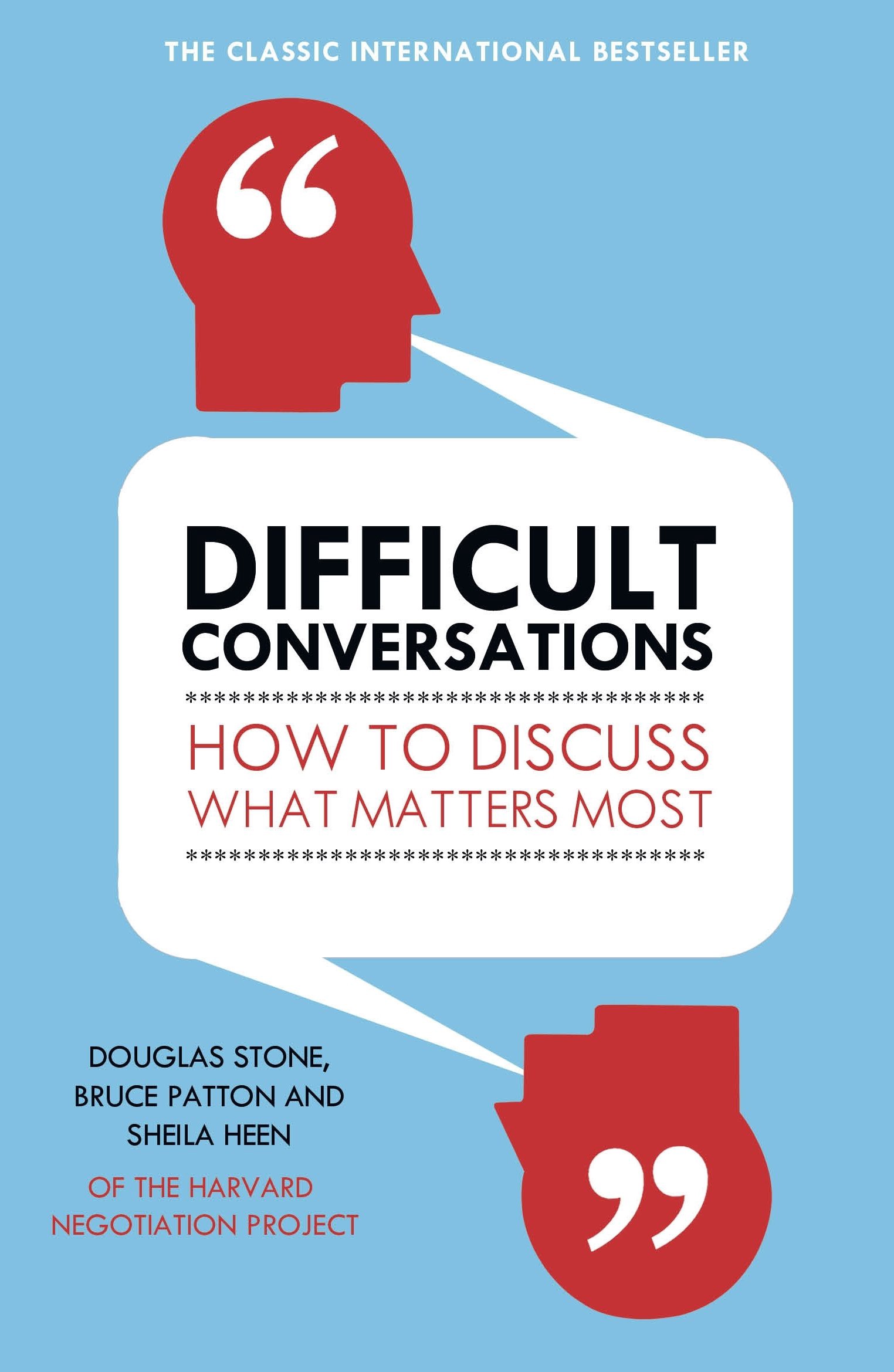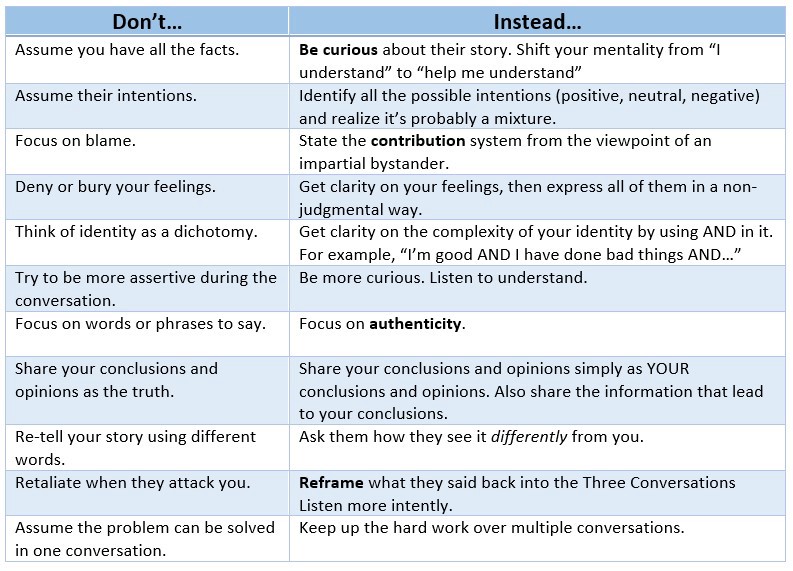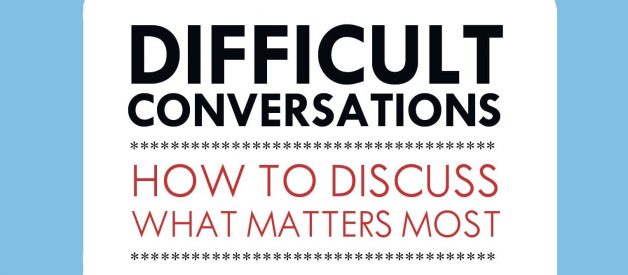Here are my key highlights taken from the book Difficult Conversations by Douglas Stone, Bruce Patton, and Shelia Heen. You should read this post (and perhaps the book) if you are preparing for a difficult conversation or experiencing communication challenges with people.
 Source
Source
In this summary, I answer four questions:
- What is this book about?
- What are the main ideas and arguments?
- What is my opinion on the book?
- What was the significance of reading this book?
I hope it will be of use to you if/when you have difficult conversations.
What is this book about?
This is a practical book about how to effectively navigate and execute difficult conversations. The authors wrote this book because people simply don?t know how to handle these low-frequency but high-impact conversations. Even worse, their natural reactions in those situations are not only counter-productive but downright detrimental.
The thesis of this book is that we need to transform difficult conversations into learning conversations. To do that, we need to do a lot of heavy-lifting in preparation. The preparation work primarily involves getting clarity on Three Conversations: what happened, your feelings, and your identity. Then, during the face-to-face conversation, we?ll need to guide the direction and constantly re-direct the conversation back on course. Only when both sides feel understood can problem-solving occur. It will likely take many attempts to solve the problem.
While certainly not easy, the benefits of implementing the book?s recommendations are well worth the effort.
What are the main ideas and arguments?
The authors? main ideas are expressed in a checklist for handling difficult conversations. To understand the checklist, we first need to define some key terms.
Key Terms
The Three Conversations:
The authors divide difficult conversations into three parts:
- The What Happened? Conversation
- The Feelings Conversation
- The Identity Conversation
We must get clarity in all three conversations for ourselves before talking to the other person about these three conversations.
The What Happened? Conversation:
The first of the Three Conversations, the What Happened? Conversation is about your view of the story, how you arrived at your view via your interpretations of the facts available to you, and your intentions. It also looks at the contribution of both sides that led to the problem.
The authors argue that the problem is not getting the facts right. Rather, the problem is that there?s conflicting perceptions, interpretations, and values that the two sides don?t understand about each other. To make progress, both sides need to focus on learning about each other?s perspectives.
Intentions:
Intention is the reason behind an action. It can be positive (to help someone), negative (to hurt someone), or neutral (unrelated to someone).
The authors argue that we need to fight our automatic act of assuming negative intentions from the other party. Instead, we should assume complex intentions that have positive, neutral/unrelated, and negative elements.
The authors also argue that during the conversation, we should not focus on executing certain actions or saying specific phrases. Rather, we need authentically good intentions, such as to understand them better and to solve the problem. To quote, ?If your intentions are good, even clumsy language won?t hinder you.?
Contribution:
It?s never 100% one person?s fault; both sides contributed to the problem. The authors argue we should focus on contribution rather than blame.
The Feelings Conversation:
The second of the Three Conversations, the Feelings Conversation is about getting clarity on your feelings. To do this, we need to reflect on both sides? contribution, intentions, and impact on the other party.
The authors make several arguments about the Feelings Conversation:
- The process of clarifying our initially strong feelings can actually change them.
- We shouldn?t express our feelings to the other party until we are clear on them.
- Once we are clear on our feelings, we need to express all our feelings, otherwise, we will still feel the urge to blame. (this applies to both sides)
- When we do express our feelings, the intention must not be to accuse or blame the other party. Rather, the intention should be purely to state the impact on us so that they don?t have false assumptions or information gaps.
- Only when both sides no longer have the urge to blame can the conversation move to the problem-solving stage.
The Identity Conversation:
The third of the Three Conversations, the Identity Conversation is about facing yourself and your values. This conversation asks three big questions:
- Am I competent?
- Am I a good person?
- Am I worthy of love?
The authors argue people need to stop viewing their identity as a dichotomy (e.g., I am competent or not competent, good or bad, worthy or not worthy) and instead view it as highly complex. To do this, we should use the word AND in our identity. For example, I am a good person AND I have done bad things AND I?m working on forgiving myself AND I am still worthy of love despite my faults.
The authors also argue that getting your identity attacked during difficult conversations is inevitable. Therefore, the important thing is regaining your balance quickly. To do that, you must accept your identity as complex and verbalize it when the attacks happen.
Learning Conversation:
A learning conversation is what difficult conversations should become if the guidelines from the book are implemented. It?s a conversation that effectively resolves the problems present in difficult conversations.
The Third Story: In a difficult conversation, each party see?s their side of the story. The Third Story is the perspective of an impartial observer. The impartial observer focuses on the difference between the two parties? stories and does not side with either of them. A Learning Conversation starts with the Third Story.
Reframing:
Reframing is when you take something counter-productive said by the other party and link it back to the Three Conversations so that the conversation stays productive.
The author argues that the other party will most likely continuously steer the conversation off-track, so it will be your job to steer it back on-track by using reframing.
Listening:
Listening in this case means listening with a curious mindset, with the intention of understanding the other person and making sure they feel heard and understood.
The author argues that Listening is the most powerful tool to keep the conversation constructive because the conversation can?t move in a more positive direction until the other person feels understood.
The Checklist
Step 1: Prepare by going through the Three Conversations for both sides.
- What happened? (both stories, intentions, and contribution)
- Be clear on your emotions
- Ground your identity
Step 2: Check your purposes and decide whether to even raise the conversation.
- Good purposes: learning, sharing, and problem solving
- Bad purposes: blaming, judging
Step 3: If you decide to raise the issue, start from the Third Story.
- Describe the problem as the difference between your two stories.
- Share your purposes for raising the issue
- Invite them to join you as a partner in sorting out the conversation together
Step 4: Explore their Three Stories. Then yours.
- Listen to understand
- Show that you understand by paraphrasing
- Share your own view without judging them
- When they bring the conversation off-course, reframe it back on track
Step 5: Problem solve.
- Invent new options that meet both sides? needs
- Look into standards about what should happen
- Talk about how to keep communications open going forward
To accompany this checklist is a list of mistakes and actions-to-do instead.

What is my opinion on the book?
I think the book was well worth the read and the effort I put in to understand it.
To me, the biggest insights were
- Don?t focus on specific actions or phrases; instead, focus on being authentic
- Focusing on Contribution instead of blame
- Intentions aren?t black or white; they are complex mixtures
- Starting the conversation with the Third Story
- People won?t be ready for change until they feel understood
- If we don?t express all our feelings, we will still feel the urge to blame
What was the significance of reading this book?
When I was reading this book, I didn?t have any major difficult conversation happening in my life, but I did about a year ago, and I sure wish I had read the book then. Looking back, I made all the mistakes the book pointed out, including focusing on blame, assuming negative intentions, starting the conversation from my perspective, believing I had all the facts, retaliating when attacked, and assuming the problem can be solved in one conversation.
I suspect I will encounter difficult conversations in the future. So after reading this book and writing down my notes, I feel much more ready to handle difficult conversations in the future.


